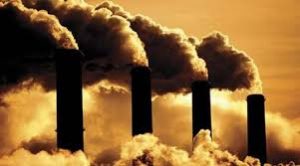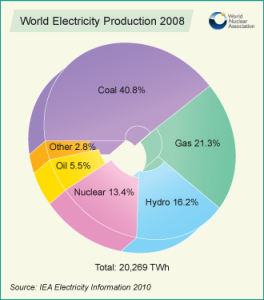Newspaper Article 28/02/2014
Pakistan has struggled with scheduled and unscheduled power cuts for decades. Problem started becoming particularly chronic since 2005 due to rise in oil prices. Bill for oil import currently stands at $14 billion approximately. “Pakistan has been facing rising oil prices and declining gas reserves as well as tight foreign account situation, rendering the reliance on import of oil to fuel power plants increasingly unaffordable,” the Asian Development Bank said in a recent statement.
Power outages are now costing about two percent of GDP per year. Ironically, Pakistan’s energy crisis is not as much related to production-demand imbalance as it is to the overall high production cost.  Existing installed generation capacity is greater than peak summer demand. However, exorbitant production cost makes the electricity unaffordable for the domestic consumer and non-competitive for the commercial/industrial users. Hence, government purchases electricity on higher prices and sells it to the consumers on subsidised tariff; the cumulated cost differential is referred to as circular debt—indeed a misnomer. Core issue confronting energy managers of Pakistan is to find cheaper add-ons to reconfigure the energy mix for producing power at affordable price. Coal and nuclear power generation processes offer the cheapest per unit generation cost after hydel and domestic gas. With building of some large scale dams irretrievably politicised and dwindling supply of local gas, the choice of cheap electricity is largely narrowed down to coal and nuclear power plants.
Existing installed generation capacity is greater than peak summer demand. However, exorbitant production cost makes the electricity unaffordable for the domestic consumer and non-competitive for the commercial/industrial users. Hence, government purchases electricity on higher prices and sells it to the consumers on subsidised tariff; the cumulated cost differential is referred to as circular debt—indeed a misnomer. Core issue confronting energy managers of Pakistan is to find cheaper add-ons to reconfigure the energy mix for producing power at affordable price. Coal and nuclear power generation processes offer the cheapest per unit generation cost after hydel and domestic gas. With building of some large scale dams irretrievably politicised and dwindling supply of local gas, the choice of cheap electricity is largely narrowed down to coal and nuclear power plants.
Out of these two, cheapest way of power generation is nuclear power plants; per unit cost becomes quite cheap if the power plant capacity is more than 1000 MW. Pakistan’s over four decades experience of safely operating the nuclear power plants and massive coal reserves in Thar make coal and nuclear power generation a viable strategy to have cheaper electricity. Coupled with development of whatever large dams can be constructed, relief to load shedding and reduction of tariff should begin to be increasingly visible in 4-7 years. Moreover, Thar coal has convinced the government that Pakistan could be very close to a solution to its energy woes. Energy-starved Pakistan has rightly set its sights on a coal and nuclear fired power plants.
Government has now decided to enhance the share of coal in the overall energy mix up to 18% by 2030. Prime Minister Nawaz Sharif and former President Asif Ali Zardari jointly inaugurated the construction of a $1.6 billion coal plant in Thar, demonstrating their shared goal of ending the nation’s power crisis. Government has also started the construction of a 66000 Megawatt coal-fired plants in Gadani. A 600 megawatt plant has also been approved for Jamshoro. In addition, 6,000 Megawatts of electricity will be generated through a new coal power initiative in Punjab at the cost of around $10 billion. Moreover, a number of existing oil-based thermal plants are being converted to coal. Due to expensive oil and a rapidly depleting supply of natural gas, country’s private and public plants are switching their oil-plants to coal. This is a major and historic fuel switching plan. Coal is one of the major sources for producing cheaper electricity; per unit cost is Rs 9 per Kwh as compared to Rs 19 Kwh from oil.
Last November, Prime Minister Nawaz Sharif performed the ground breaking ceremony of Pakistan’s largest nuclear power projects, Kanupp-II and Kanupp-III. China is providing the two reactors. When completed in November 2019, these would add 2,200 MW to Pakistan’s electric power, at a very cheap rate. Average price of power generated by Chashma-3 and 4 would be around Rs 9.59 per unit. Due to economy of scales, new Kanupp category plants would produce much cheaper electricity than the Chashma plants. Pakistan plans to add 40,000 MW to country’s energy-mix by 2047.
Following these land mark decisions, various vested interests have launched a campaign to tarnish these two ways of generating cheaper power. Coal is maligned for its Carbon emissions and nuclear power generation by raising safety concerns. However, in our energy mix, share of coal power is only one percent as compared to world average of 40%. India generates 69 percent of its electricity from coal while Europe generates 60 per cent. Pakistan causes only 0.51 percent of global green house gases’ emission. Likewise Pakistan has only three operational nuclear plants as compared to 435, the world over.
However, in our energy mix, share of coal power is only one percent as compared to world average of 40%. India generates 69 percent of its electricity from coal while Europe generates 60 per cent. Pakistan causes only 0.51 percent of global green house gases’ emission. Likewise Pakistan has only three operational nuclear plants as compared to 435, the world over.
Flimsy concerns are being been raised about nuclear power generation— especially the technological and safety aspects. Post-Fukushima, nuclear power plants are being equipped to cope with the most unlikely scenarios of total blackout and non-functionality of several of the engineered safety features incorporated in these plants. These safety features would be inbuilt in new Karachi plants.
After Fukushima, most countries have continued to construct and plan for new power plants. In Asia, number of under-construction and planned power plants is the highest in the world; around 49 reactors are presently under construction, and there are firm plans for over a 100 more. Countries where these projects are underway include India, China, South Korea, Pakistan, Bangladesh, UAE, Iran etc. These 149 reactors will be in addition to the 435 reactors already in operation in the world.
Questions are being raised about the design model of Karachi power plants— ACP 1000. It is based on the PWR concept. Very similar to this, hundreds of systems have been operating around the world for more than 50 years.  Hence it is not an unproven design. The ACP 1000 uses the basic PWR design with safety improvements to meet the current safety targets of Generation-III reactors. It is based on the earlier CPR1000 design, which has been used in 15 plants now under construction in China, of which the first unit started operations in 2010. Some statements in the media about earthquake and tsunami risk for the K-2/K-3 site are completely unfounded. In fact, many technical studies have been carried out for the site to ensure that the plant would survive the largest tsunami that can be expected in the region. The maximum predicted earthquake could produce a ground acceleration of 0.2g, while the plant has been designed to withstand a ground acceleration of 0.3g. Similarly, the best technical analyses have indicated that highest tsunami height expected at Karachi is about 2.8 m above Mean Sea Level, while the K-2/K-3 ground level is 12 m above Mean Sea level.
Hence it is not an unproven design. The ACP 1000 uses the basic PWR design with safety improvements to meet the current safety targets of Generation-III reactors. It is based on the earlier CPR1000 design, which has been used in 15 plants now under construction in China, of which the first unit started operations in 2010. Some statements in the media about earthquake and tsunami risk for the K-2/K-3 site are completely unfounded. In fact, many technical studies have been carried out for the site to ensure that the plant would survive the largest tsunami that can be expected in the region. The maximum predicted earthquake could produce a ground acceleration of 0.2g, while the plant has been designed to withstand a ground acceleration of 0.3g. Similarly, the best technical analyses have indicated that highest tsunami height expected at Karachi is about 2.8 m above Mean Sea Level, while the K-2/K-3 ground level is 12 m above Mean Sea level.
There are ample potentials for generating additional 53280 MW of electricity form water. Some of the projects are under development; some cannot be taken up due to lack of national consensus. However, one of the most un-tapped water resources is the flood water. Pakistan’s Water cycle is problematic; water surplus spike of a few months is interspersed by a long spell of water shortage. Nevertheless, sustained availability of adequate water for power generation can be assured by building water reservoirs for storing water during water surplus periods and regulating the supply during water scarce tenures.
While coal and nuclear fuels are destined to be the mainstay of power generation, it is essential that development of hydel infrastructure should continue to get due attention. It is indeed hydel-nuclear-coal trio that can steer us out of power crisis.
Carried by The Nation on February 24, 2014.
Disclaimer: The views expressed are those of the writer and are not necessarliy reflecftive of IPRI policy.
